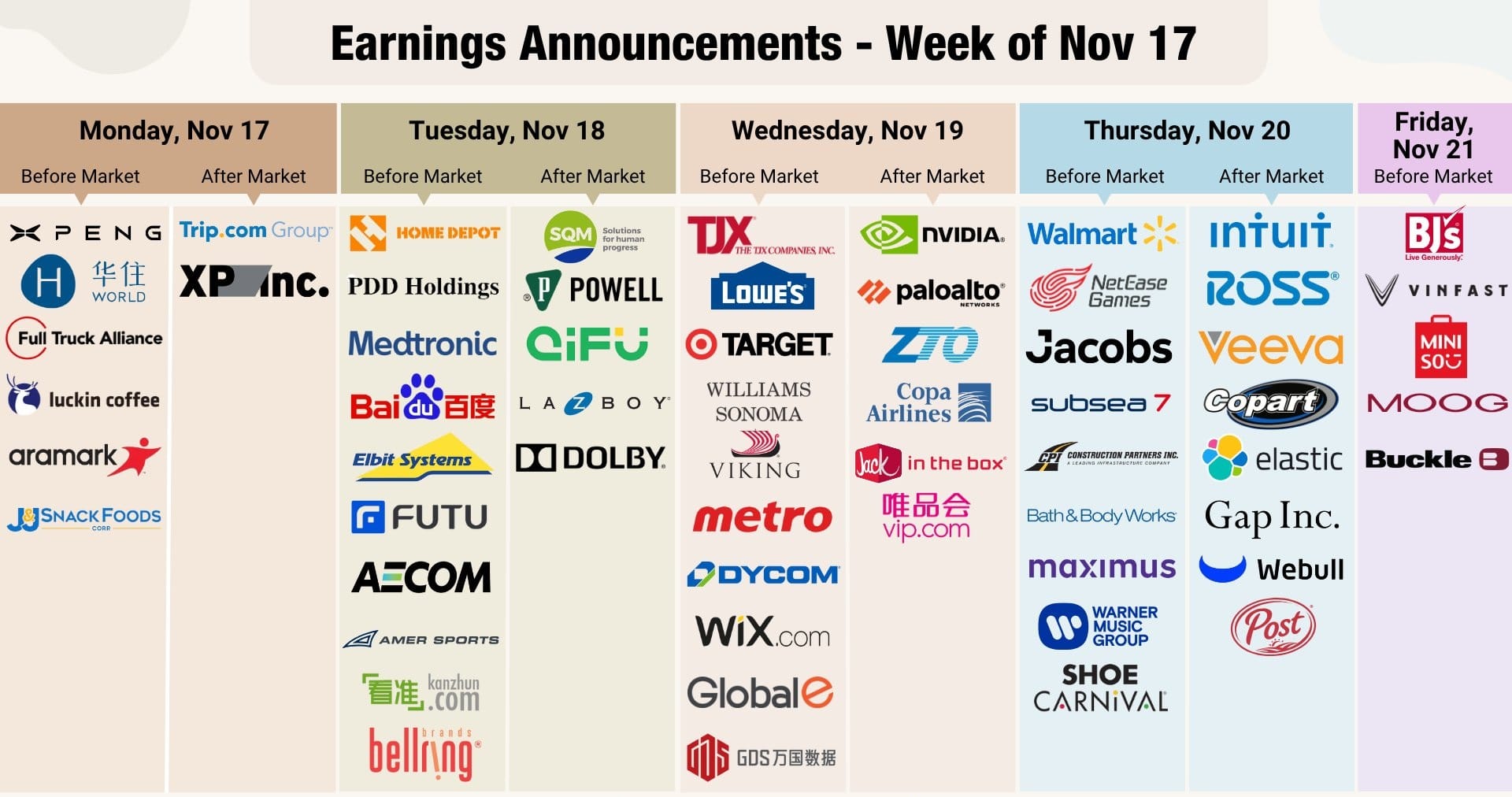North America News
Stocks End August Lower as Tech, Semis Weigh; Rate-Cut Bets Hold Firm
Dow -92.02 at 45,544.88 · Nasdaq -41.60 at 21,455.55 · S&P 500 -24.61 at 6,460.26
U.S. equities closed lower Friday in a quiet, holiday-shortened session, as weakness in technology and semiconductor stocks erased early momentum and left markets consolidating after a strong August run.
All three major indexes finished in the red, with the Dow down 0.2%, the Nasdaq off 0.2%, and the S&P 500 lower by 0.4%. Despite today’s slip, August still delivered fresh record highs across the board.
Tech and semis drag on market
The day’s losses were concentrated in the mega-cap tech and semiconductor space, where sellers dominated after earnings and guidance disappointments:
- NVIDIA (NVDA) fell 3.3%
- Dell (DELL) dropped nearly 9%
- Marvell (MRVL) sank 18.6%
- Caterpillar (CAT) lost 3.6% after warning of higher tariff-related costs
The Philadelphia Semiconductor Index slid 3.2%, underscoring the sector’s drag. Information technology (-1.6%) was the weakest S&P sector, joined by consumer discretionary (-1.1%) and industrials (-1.0%).
Defensive groups showed relative strength, with health care (+0.7%), consumer staples (+0.6%), real estate (+0.6%), and energy (+0.5%) posting gains.
Light volume ahead of Labor Day
Trading volumes were thin as investors stepped back before the three-day weekend. Small-cap and mid-cap benchmarks also closed lower, with the Russell 2000 and S&P MidCap 400 both down 0.5%.
Fed cut expectations steady
Economic data offered few surprises. July PCE inflation rose 0.2% month-over-month, with core PCE up 0.3%, keeping year-over-year rates stuck at 2.6% and 2.9%—above the Fed’s 2% target but in line with forecasts.
Fed Governor Waller signaled support for a 25-basis-point cut in September, saying more cuts are likely in coming months. Futures markets remain confident: CME FedWatch shows an 86.9% chance of a September cut, unchanged from yesterday.
Consumer sentiment and trade data
- University of Michigan Consumer Sentiment fell to 58.2 (vs. 58.6 preliminary and 61.7 in July), reflecting broad-based pessimism.
- Chicago PMI slipped to 41.5 from 47.1, highlighting weakness in Midwest manufacturing.
- Advance trade deficit widened to $103.6B, while retail and wholesale inventories both rose 0.2%.
Treasury yields hold steady
The bond market was subdued: the 2-yr yield fell 2 bps to 3.62%, while the 10-yr yield edged up 2 bps to 4.23%.
August wrap-up
Even with Friday’s retreat, equities logged strong year-to-date gains:
- Nasdaq +11.1% YTD
- S&P 500 +9.8% YTD
- Dow +7.1% YTD
- Russell 2000 +6.0% YTD
After a record-setting month, stocks ended August with a whimper—but rate-cut hopes, steady earnings, and strong YTD performance keep bulls engaged heading into September.
Atlanta Fed GDPNow Tracker Surges for Q3
The Atlanta Fed’s GDPNow model sharply upgraded its estimate for third-quarter growth, projecting a 3.5% annualized rate as of August 29, up from 2.2% earlier this week. The jump reflects stronger-than-expected data on economic activity, signaling resilience in U.S. growth momentum heading into the fall.
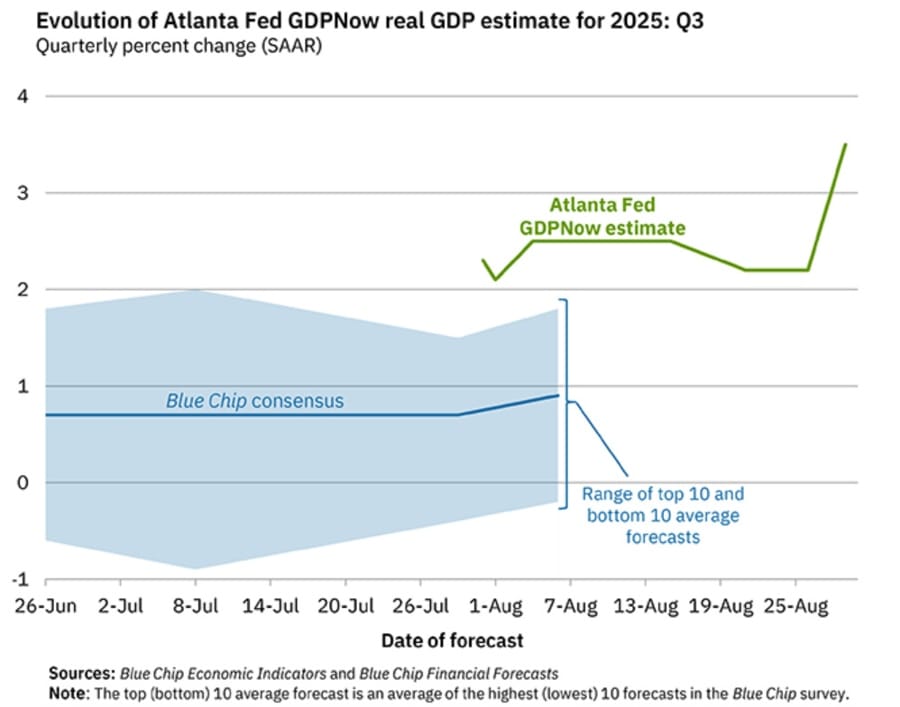
In their own words:
After recent releases from the US Census Bureau and the US Bureau of Economic Analysis, the nowcasts of third-quarter real personal consumption expenditures growth and second-quarter real gross private domestic investment growth increased from 2.2 percent and 4.4 percent, respectively, to 2.3 percent and 6.1 percent, while the nowcast of the contribution of net exports to third-quarter real GDP growth increased from -0.36 percentage points to 0.59 percentage points.
U. Michigan Consumer Sentiment Softens in Final Reading
The University of Michigan’s final August consumer sentiment index came in at 58.2, down from July’s 61.7 and slightly below the preliminary 58.6.
- Current conditions: 61.7 (vs. 68.0 prior)
- Expectations: 55.9 (vs. 57.7 prior)
Inflation expectations eased modestly from the prelim numbers but remain elevated: - 1-year outlook: 4.8% (vs. 4.5% July)
- 5-year outlook: 3.5% (vs. 3.4% July)
Surveys of Consumers Director Joanne Hsu notes: “Perceptions of many aspects of the economy slipped. Buying conditions for durable goods subsided to their lowest reading in a year. Expectations for business conditions and labor markets contracted in August as well. That said, expectations for personal finances held steady this month, albeit at relatively subdued levels relative to a year ago.”
Dallas Fed Trimmed Mean PCE Moderates in July
The Dallas Fed’s July trimmed mean PCE inflation reading pointed to moderating price pressures:
- 1-month annualized: +1.9% (vs. +3.4% prior)
- 6-month annualized: +2.6% (vs. +2.8% prior)
- 12-month annualized: +2.7% (unchanged)
While the 1-month figure dropped sharply, analysts warn the short horizon is volatile. The steadier 6- and 12-month measures suggest inflation remains on a gradual cooling path.
U.S. Core PCE Matches Forecasts at 2.9% YoY
The July Core PCE price index — the Fed’s preferred inflation gauge — rose 2.9% year-over-year, in line with expectations and up slightly from 2.8% prior. On a monthly basis, core prices advanced 0.3%, also matching forecasts.
Headline PCE stayed at 2.6% YoY, unchanged from June. Personal income rose 0.4%, while spending increased 0.5%, pointing to steady consumer strength despite elevated inflation.

Court Delays Ruling on Fed Governor Lisa Cook Case
A federal judge on Friday declined to rule on the motion to dismiss the lawsuit involving Fed Governor Lisa Cook. Both parties were instructed to submit additional filings by next Tuesday. The court said the delay preserves the status quo while it weighs the case. The Fed, in a separate filing, stressed it has no position on the lawsuit but urged a “prompt ruling” to clear the uncertainty surrounding the matter.
Caterpillar Warns of Larger Tariff Hit
Caterpillar Inc. shares slipped in after-hours trading after the company revised its tariff cost outlook.
The industrial giant now expects a $1.5 billion to $1.8 billion impact, up from a prior forecast of $1.3–$1.5 billion. For Q3 alone, the firm anticipates a $500–$600 million hit.
While Caterpillar kept its full-year sales forecast unchanged, it warned that operating profit margins will likely land near the bottom of its target range. Management noted that tariff negotiations remain “fluid,” but said mitigation efforts are underway.
Senate Hearing for Trump’s Fed Nominee Set for September 4
The Senate Banking Committee scheduled a September 4 hearing at 10 a.m. for Stephen Miran, President Trump’s nominee to the Federal Reserve Board.
The accelerated process is aimed at ensuring Miran secures a seat on the Federal Open Market Committee (FOMC) ahead of the September 16–17 meeting.
Miran, currently chair of the President’s Council of Economic Advisers, has called for sharply lower interest rates, argued tariffs do not fuel inflation, and endorsed giving the White House stronger control over the Fed — including authority to dismiss its leadership.
Fed Governor Waller Signals Support for Rate Cuts
Federal Reserve Governor Christopher Waller said it is time for the U.S. central bank to begin shifting rates toward a neutral stance.
He voiced support for a 25 basis point cut at the September meeting, with further reductions likely over the next three to six months. Waller said he pushed for a cut in July and is now even more convinced.
According to his estimates, the policy rate remains 1.25 to 1.50 percentage points above neutral, while core inflation (excluding temporary tariff effects) is close to 2%. He warned that labor demand is weakening, increasing downside risks to the job market.
Waller described tariffs as “a tax” that does not meaningfully increase inflation. He also reiterated that while U.S. debt is on an unsustainable path, it is not an immediate concern.
Powell’s Dovish Turn Fuels Stock Rally
Federal Reserve Chair Jerome Powell’s pivot toward looser monetary policy has ignited equity markets, with Societe Generale’s Manish Kabra highlighting a record outperformance of the Russell 2000 over the S&P 500 — the biggest single-day gain since Donald Trump’s 2016 election victory.
Kabra noted that small-cap companies, more reliant on borrowing for growth, are the biggest winners from lower financing costs. Still, he added that the policy shift should benefit the broader market, including Big Tech, with ample liquidity likely boosting the so-called “Magnificent Seven.”
Looking forward, Kabra expects over 100 basis points in rate cuts over the coming year, positioning monetary policy as the primary driver for equities.
Trump Administration Introduces Temporary Flat Duties on Imports
A senior official confirmed that package imports into the U.S. will face flat tariffs of $80 to $200 for the next six months before transitioning to product-specific duty rates.
This move follows President Trump’s decision to scrap the “de minimis” exemption, which previously allowed Americans to purchase low-value foreign goods duty-free. Now, consumers ordering from overseas will face a minimum $80 tax, capped at $200.
According to the official, Customs and Border Protection (CBP) has already collected over $492 million in additional duties on shipments from China and Hong Kong since the exemption was revoked. Washington has engaged with international partners to limit disruption, with the U.K., Canada, and Ukraine confirming mail flow to the U.S. will not be interrupted. Officials emphasized that there will be no carve-outs or exceptions to the de minimis repeal.
Canada GDP Contracts in Q2, Traders Eye BoC Cuts
Canada’s economy shrank more than expected in the second quarter, contracting at a -1.6% annualized rate versus forecasts of -0.6%. This follows a downward revision of Q1 growth to -2.0% from +2.2%.
June GDP slipped 0.1% (vs. +0.1% expected), while the advance July estimate showed a modest +0.1% gain. The weak data nudged rate cut bets higher, with markets now pricing 27 bps of BoC easing by year-end, up from 24 bps before the release.
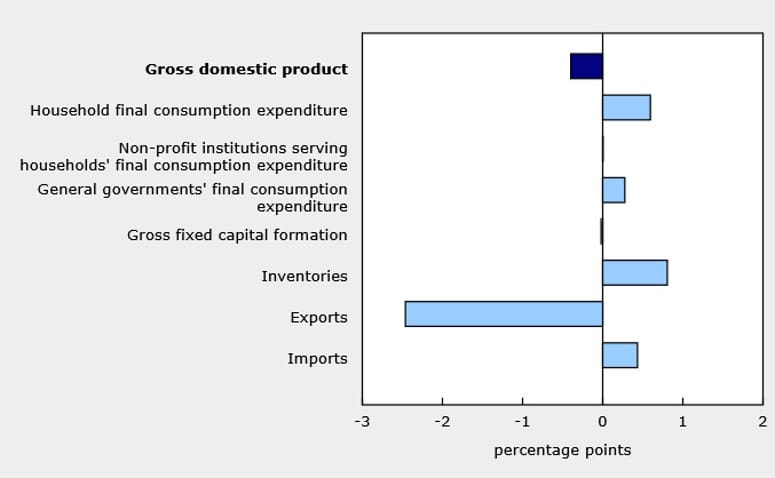
Canada Braces for Trump Tariffs to Stay
Canadian officials told the Financial Times they do not expect President Trump to fully roll back tariffs on Canadian exports.
The report, citing unnamed sources, signals that Ottawa is preparing for a prolonged period of trade friction even as broader negotiations continue.
Brazil and Mexico to Finalize Trade Deal in 2026
Brazilian Vice President Geraldo Alckmin said negotiations with Mexico on a new trade pact are on track to conclude by June 2026, with a signing ceremony planned for August 2026.
The agreement is expected to complement existing frameworks and expand bilateral trade between Latin America’s two largest economies.
Commodities News
Gold Tests Resistance — Breakout or Fakeout?
Gold climbed back toward the top of its four-month range, challenging resistance near $3,450. While momentum has been supported by Powell’s dovish shift last week, falling real yields, and stronger inflation expectations, the rally lacks a fresh catalyst. Traders suspect this may be a final parabolic push before a correction.
Short term, sellers are expected to defend resistance with downside targets near $3,245, while buyers look for a breakout to drive prices toward new highs. Next week’s U.S. labor data, capped by Friday’s NFP release, will be the key driver for rate expectations — and for gold’s next move.
Baker Hughes Rig Count: U.S. -2, Canada -5
The Baker Hughes weekly rig count showed continued declines:
- U.S. rigs: -2 to 536, with oil rigs down 1, gas down 3, and misc. unchanged. Total is down 47 rigs YoY. Offshore rigs held steady at 13, down 6 from last year.
- Canada rigs: -5 to 175, with oil down 3, gas down 1, and misc. down 1. The total is down 45 rigs YoY.
The data underscores weakening drilling activity as producers respond to softer prices and efficiency gains.

Confusion Over Russian Oil Exports
Conflicting data has clouded the picture of Russian oil flows, Commerzbank said.
Reuters reported that export plans for Western ports were raised by 200,000 barrels/day in August, to 2 million bpd, as refinery outages freed up more crude.
But Bloomberg data showed actual shipments fell to 2.72 million bpd last week, a four-week low and down more than 10% from the prior week. The four-week average is now near a six-month low at 3.06 million bpd.
The biggest drops were at the Ust-Luga and Novorossiysk ports, both recently targeted by Ukrainian drone strikes.
Iron Ore Prices Lifted by China Steel Output Cuts
Iron ore in Singapore rose 1.7% to above $104/t, the highest in over two weeks, after reports that China plans to cut steel production through 2026, ING said.
Key points from the planning document:
- Reduce overcapacity by closing outdated furnaces
- Boost “value-add” by 4%
- Invest in technology, promote steel in construction
- Strengthen raw material supply chains
From January–July, China’s steel exports hit a record high, prompting anti-dumping measures abroad. Crude steel output fell 3.1% y/y over the same period.
Oil Prices Gain as Peace Hopes Fade
Oil prices climbed after German Chancellor Merz said a meeting between Putin and Zelensky is unlikely, undermining hopes for a Ukraine-Russia peace deal.
Meanwhile, Russia launched new strikes on Kyiv, including buildings housing the EU mission and British Council. ING said the continued conflict heightens risks of further sanctions and tariffs.
On refined products:
- ARA gasoil stocks rose to 2.09mt, their fourth weekly gain, now near the five-year average.
- Gasoline stocks fell to 991kt, continuing a year-long decline, with demand in key markets staying firm.
- Singapore product inventories fell 346k barrels to 47.54m.
On natural gas, Dutch TTF prices dropped 2.95%, despite reduced Norwegian supply, as EU storage rose to 77% full, though still below the 84% seasonal norm.
Gold Hits $3,400 as White House–Fed Clash Escalates
Gold prices surged past $3,400 per ounce, reaching a five-week high, as tensions between the Trump administration and the Federal Reserve rattled markets, according to Commerzbank’s Carsten Fritsch.
The move came despite unchanged Fed cut expectations: markets are pricing an 85% chance of a September cut and just over 50bps of easing by year-end.
The real driver has been political: Fed Governor Lisa Cook filed a lawsuit over her dismissal by President Trump, while Vice President Vance argued that elected officials should have a say in monetary policy — raising doubts about Fed independence.
Gold ETFs saw inflows of nearly 15 tons in two days, though Fritsch warned upside above $3,400 looks limited.
U.S. Oil Inventories Fall Sharply
U.S. crude stockpiles dropped by 2.4 million barrels last week, according to the Department of Energy, exceeding both forecasts and API data, Commerzbank said.
Product breakdown:
- Gasoline: -1.2 million barrels
- Distillates: -1.8 million barrels
Gasoline demand hit a two-month high, while distillate demand climbed to its highest August level in four years. Distillate inventories now stand nearly 15% below the five-year average.
Russian Oil Flows to India Set to Rebound
Russian crude shipments to India dropped nearly 40% last week, to just over 800,000 barrels per day — the lowest since October 2022, Bloomberg data showed.
However, Commerzbank noted that traders expect flows to recover in September as producers cut prices to offload surplus supply caused by refinery outages. Indian refiners may boost purchases by 10–20% (150k–300k bpd).
Still, damage to Russia’s energy infrastructure, particularly the Ust-Luga oil port, may cap exports. Repairs could take months, with the port expected to operate at only half-capacity in September.
Europe News
ECB Survey: Inflation Expectations Stuck at 2.6%
The ECB’s July Consumer Expectations Survey found one-year-ahead inflation expectations unchanged at 2.6%, still above the central bank’s 2% target.
84.8% of respondents expect prices to rise over the next 12 months, the highest share since April. Analysts say inflation expectations may be hitting a floor.
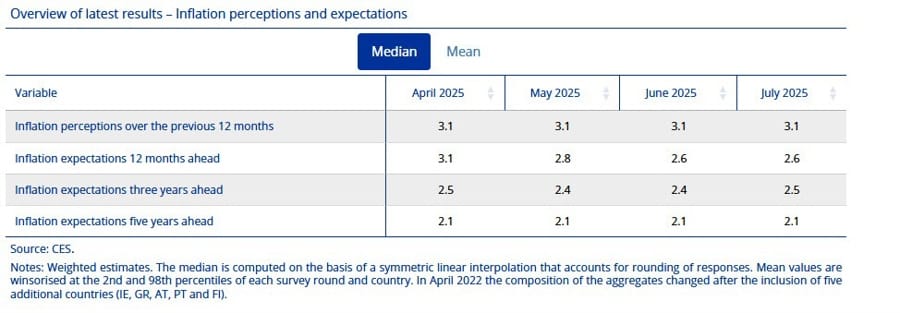

German CPI Rises to 2.2% in August
Germany’s flash CPI climbed 2.2% y/y in August, above expectations of 2.1% and up from July’s 2.0%.
The HICP measure registered +2.1% (vs. 2.0% expected, 1.8% prior).
Core inflation held steady at 2.7% for the third month in a row — still above the ECB’s 2% goal.
Germany Import Prices Fall in July
Germany’s import price index slipped 0.4% month-on-month in July, according to Destatis. That was a deeper decline than the expected -0.3%, following a flat reading in June.
Even after excluding energy, import prices dropped 0.4%. By category:
- Intermediate goods: -0.5%
- Capital goods: -0.2%
- Durable consumer goods: -0.4%
Weakness was broad-based across all sectors.
German Retail Sales Drop More Than Expected
Retail sales in Germany fell 1.5% in July, sharply below expectations for -0.4% and reversing June’s +1.0% gain.
Food retailers recorded a 1.8% monthly drop, while non-food sales fell 0.7%. Compared with July 2024, however, overall sales were still up 1.9%.
German Jobless Rate Steady as Unemployment Falls
Germany’s labor market improved slightly in August as unemployment fell by 9,000, compared with expectations for a +10,000 increase.
The unemployment rate held steady at 6.3%, in line with forecasts. The Federal Employment Agency noted that the market is still shaped by the recent economic downturn, though “early signs of stabilization” are emerging.
German State Inflation Data Points to Higher National Print
August CPI readings across key German states showed price pressures rising:
- Bavaria: +2.1% y/y (prior 1.9%)
- North Rhine-Westphalia: +2.0% y/y (prior 1.8%)
- Saxony: +2.2% y/y (prior 1.9%)
- Baden-Württemberg: +2.5% y/y (prior 2.3%)
The firmer state-level data suggests that the national CPI release will likely come in around 2.2% y/y, above the earlier estimate of 2.1%.
Italy Confirms Q2 GDP Contraction
Italy’s economy contracted 0.1% quarter-on-quarter in Q2, final data confirmed, matching preliminary estimates.
That marks a reversal from Q1’s +0.3% growth, underscoring persistent weakness in the Italian economy.
Italy CPI Holds at 1.6% in August
Preliminary data showed Italian consumer prices rising 1.6% y/y in August, slightly below the expected 1.7% and down from July’s 1.7%.
The HICP reading came in at 1.7%. Core inflation picked up modestly to 2.1%, from 2.0% in July, likely reinforcing the ECB’s cautious stance.
France Confirms 0.3% GDP Growth in Q2
Final data from INSEE confirmed France’s economy expanded 0.3% quarter-on-quarter in Q2, matching preliminary estimates and up from +0.1% in Q1.
Breakdown:
- Household consumption: +0.10 percentage points
- Inventory changes: +0.52pp
- Net trade: -0.27pp
France CPI Slows Slightly in August
Preliminary figures showed French consumer prices rising 0.9% year-on-year in August, just below the expected 1.0% and easing from July’s +1.0%.
The HICP measure registered +0.8%, versus 0.9% expected. On a monthly basis, CPI climbed 0.4%, marking the third straight increase.
Service inflation slowed to 2.1%, down from 2.5% in July.
Spain CPI Holds at 2.7% in August
Spain’s flash CPI for August showed prices rising 2.7% year-on-year, matching July’s pace but slightly below the expected 2.8%.
The HICP measure also came in at 2.7%. Core inflation ticked higher to 2.4%, up from 2.3% in July — reinforcing expectations that the ECB will stay cautious on rate cuts.
UK Think Tank Proposes Windfall Tax on Banks
The Institute for Public Policy Research (IPPR) recommended that Chancellor Rachel Reeves impose a windfall levy on commercial banks’ profits, particularly those linked to taxpayer-funded deposits at the Bank of England.
The group estimates the measure could raise £32.3 billion over the five-year parliament, boosting fiscal headroom by £3.6 billion.
The think tank also urged the BoE to halt active gilt sales, saying such a move would save £10 billion annually and reduce interest costs by £1.1 billion by 2030.
Asia-Pacific & World News
China Reiterates Opposition to U.S.-Taiwan Ties
Beijing repeated its firm opposition to any official contact between the U.S. and Taiwan, responding to Senator Roger Wicker’s visit to Taipei.
Wicker described the trip as a chance to “better understand the needs” of Taiwan, while President Lai Ching-te said he hopes to deepen security cooperation with Washington.
China, meanwhile, is preparing a large military parade to mark the 80th anniversary of WWII’s end, with Vladimir Putin and Kim Jong Un expected to attend.
Goldman Sachs Lifts China Stock Outlook
Goldman Sachs raised its 12-month target for the CSI 300 Index to 4,900 from 4,500, citing supportive valuations and solid profit growth.
The upgrade follows a 10% surge in the index this month, driven by liquidity and valuation expansion rather than cyclical fundamentals. While profit-taking remains a risk, Goldman sees the rally supported by momentum and favorable positioning.
China Says Consumer Confidence Needs Boosting
The National Development and Reform Commission (NDRC) acknowledged that household spending capacity and confidence require strengthening.
A spokesperson added that competition among companies has intensified, and pledged to:
- Explore additional central government support to ease local government funding pressures for social programs.
- Investigate cases of product dumping and misleading promotions.
- Strengthen oversight to curb “disorderly competition.”
PBOC sets USD/ CNY central rate at 7.1030 (vs. estimate at 7.1274)
- PBOC CNY reference rate setting for the trading session ahead.
PBOC injected 782.9bn yuan via 7-day reverse repos at 1.40%
- 361.2bn yuan mature today
- net 421.7bn yuan injection

Australian Private Sector Credit Beats Expectations
The Reserve Bank of Australia reported that private sector credit in July expanded 0.7% month-on-month, ahead of expectations for +0.6% and stronger than the prior +0.6%.
On an annual basis, growth accelerated to +7.2%, up from +6.8%. Gains were recorded across all three major credit categories.
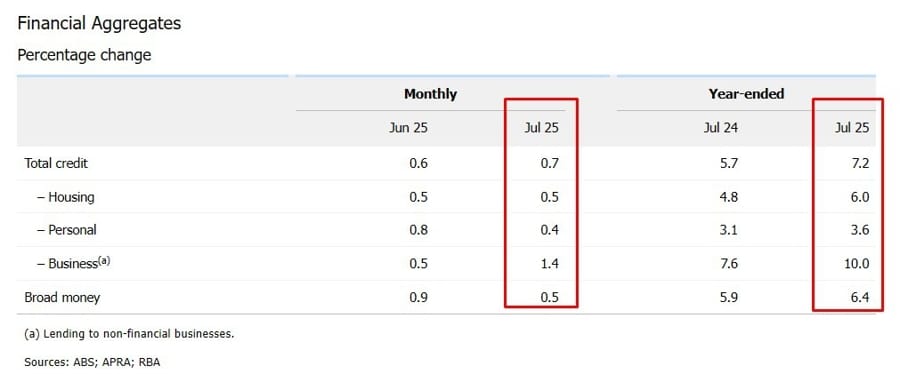
New Zealand Consumer Confidence Falls to 10-Month Low
The ANZ consumer confidence index for August dropped to 92.0, down from 94.7 in July, a 2.9% month-on-month decline.
ANZ analysts said the index now sits at its lowest level in ten months. Alongside the drop, the share of respondents who believe it’s a good time to purchase major household items also declined, remaining firmly negative.
Japan’s Jobless Rate Improves in July
Japan’s unemployment rate fell to 2.3% in July, beating expectations of 2.5% and improving from 2.5% previously.
The job-to-applicant ratio came in at 1.22, slightly below forecasts of 1.23 but unchanged from June. The figures highlight Japan’s persistently tight labor market.
Tokyo Inflation Holds Above BOJ Target
Tokyo’s August CPI rose 2.6% year-on-year, in line with expectations but down from July’s 2.9%.
Excluding fresh food, inflation also printed at 2.5%, while the core-core gauge — excluding food and energy — registered 3.1%, its highest since January 2024.
With price growth holding above the Bank of Japan’s 2% target for over three years and nominal wages rising, policymakers remain on track to continue raising short-term rates.
Japan Industrial Output Declines, Retail Sales Underwhelm
Japan’s July data showed a 1.6% month-on-month drop in industrial production, worse than forecasts for -1.0%. On a yearly basis, output fell 0.9%.
Retail sales managed a 0.3% annual increase, below expectations of +1.8% and weaker than the prior month’s 1.9%.
Looking ahead, the government projects production to rebound 2.8% in August, before edging down 0.3% in September.
Japan’s Finance Minister Monitors Rising Yields
Finance Minister Shunichi Kato said he is closely watching the recent climb in Japanese government bond yields.
He pledged continued engagement with market participants while ensuring debt policy remains responsibly managed.
Crypto Market Pulse
Crypto Market Weekly Wrap: Bitcoin, Ethereum, XRP Under Pressure
Bitcoin slipped below its 100-day EMA, trading near $108,500 support, as risk-off sentiment gripped the crypto market. Ethereum dropped 11% from its record $4,955 high, while XRP slid under $3.00, reinforcing a bearish bias.
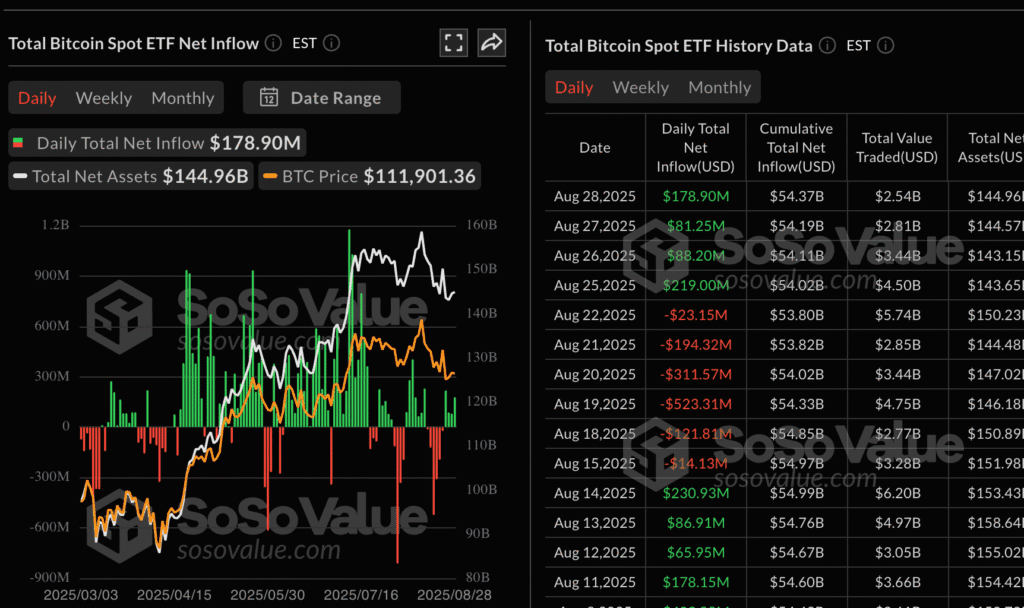
ETF data offered a mixed backdrop: U.S. spot Bitcoin ETFs posted $179M in inflows Thursday, the fourth straight day of gains, led by Ark’s ARKB (+$80M). Ethereum ETFs saw inflows of $39M, a sharp slowdown from the prior week. Traders will watch flows closely ahead of the Fed’s September meeting for fresh cues.
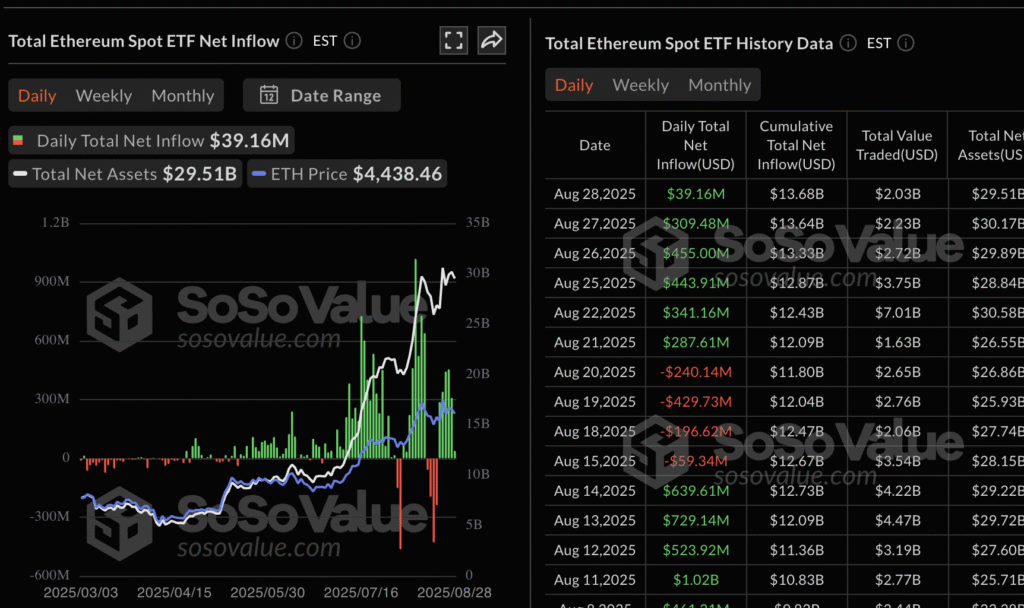
Ethereum technicals remain fragile, with price holding above $4,300 but risks skewed toward the 50-day EMA at $3,952. Both MACD and RSI signal cooling momentum.
Meme Coins Test Support as Open Interest Fades
Dogecoin (DOGE), Shiba Inu (SHIB), and Pepe (PEPE) traded at key support levels Friday, but derivatives activity showed little conviction. Open interest fell 2% for DOGE, 7% for SHIB, and 4% for PEPE, while trading volumes plunged up to 40%.

- DOGE: Dropped to $0.2151, at risk of breaking its triangle support. A close below the 50-day EMA at $0.2177 could open a path to the 200-day EMA near $0.1909.
- SHIB: Testing a key trendline; a breakdown could target $0.00001166, with further downside to $0.00001000.
- PEPE: Flashed a Death Cross as the 50-day EMA slipped under the 200-day EMA. A decisive break of $0.00000988 could send it toward $0.00000900.
Altcoin Season Index ticked up to 59, its highest in three months, but far from the 75 threshold that defines a true altseason.

Solana Surges on Record OI, Alpenglow Upgrade Vote
Solana (SOL) extended gains above the $200 level Friday as open interest hit a record $13.68B, up more than $1B in a day, signaling growing trader participation.

Institutional activity also lifted sentiment:
- Sharp Technology announced a $400M Solana digital asset treasury, with potential to expand to $1B.
- Circle minted nearly $750M USDC on Solana, boosting stablecoin liquidity.
Meanwhile, Solana validators are voting on the Alpenglow upgrade (SIMD-0326), which aims to cut block finality to 150ms from 12.8s. Current support stands at over 20% of staked tokens; 33% participation with 66% “yes” votes is required for approval.
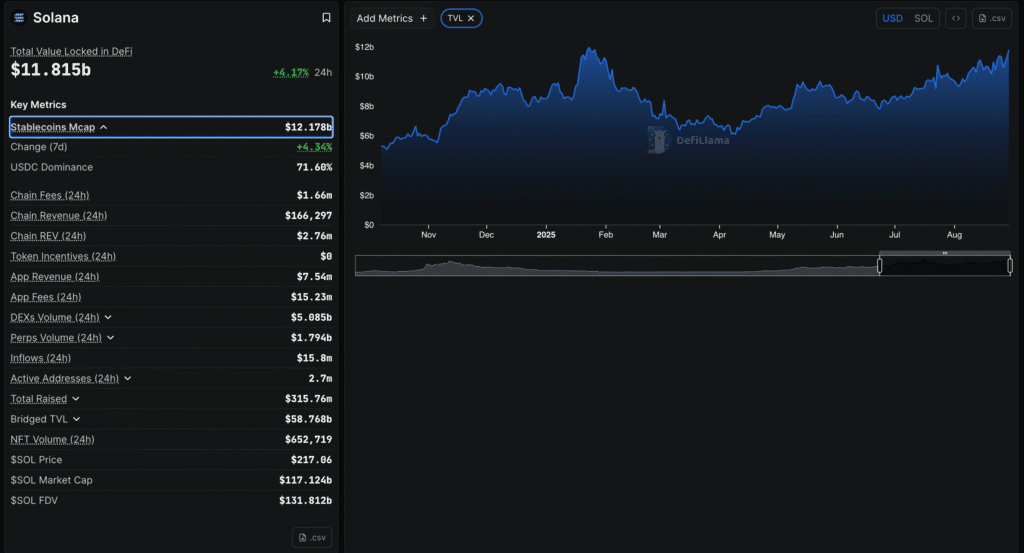
SOL targets $232 next, a key Fib retracement level. A breakout could bring the all-time high at $295 back into play.

XRP Slips Below $3, Bearish Pressure Builds
XRP extended its decline for a third straight day, sliding below the key $3.00 level and testing support near $2.80.

Futures open interest has dropped from $10.9B to $8.0B, signaling reduced conviction, while liquidations surged with $15M in long positions wiped out in the last 24 hours.

On-chain activity remains weak, with active addresses plunging from 50,000 in mid-July to just 24,000. Unless buyers regain control quickly, XRP risks another leg lower toward $2.50.
Pi Network ETP Launch Sparks Optimism, Token Unlock Looms
Pi Network (PI) rallied this week after Valour, a subsidiary of DeFi Technologies, launched the first-ever Pi-focused Exchange Traded Product (ETP) on Nordic markets. The debut fueled bullish sentiment, with CoinMarketCap ranking Pi among the top 10 tokens by positive sentiment (87.7% bullish).
Still, risks loom as 159.5M tokens are scheduled to unlock in September, threatening to increase supply pressure and cap upside momentum.
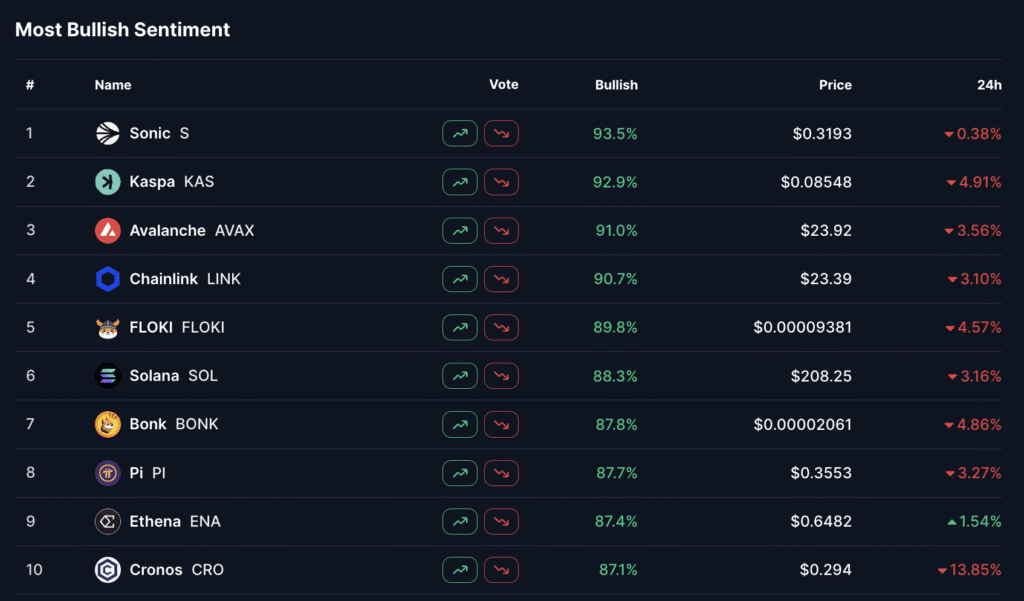
Hyperliquid (HYPE) Faces Sharp Correction as OI Shrinks
Hyperliquid (HYPE) fell sharply from its $51.51 record high, dropping 13% to trade around $44.23 on Friday. Futures data shows waning demand, with the weighted funding rate slipping to 0.0087%, down from 0.0269% earlier this week, while open interest retreated from $2.23B to $2.0B.

The selloff triggered liquidations of $1.67M in longs, leaving the token vulnerable to further downside. Technicals remain bearish, with both the MACD and RSI signaling a deeper pullback unless fresh catalysts emerge.


The Day’s Takeaway
United States
- Stocks End August Lower as Tech, Semis Weigh
U.S. equities finished Friday modestly lower in a thinly traded, pre-Labor Day session. The Dow lost 92 points (-0.2%) to 45,544.88, the Nasdaq fell 41.60 (-0.2%) to 21,455.55, and the S&P 500 dropped 24.61 (-0.4%) to 6,460.26. Despite the pullback, all three major indexes notched fresh record highs earlier in August.
Losses were concentrated in tech and semiconductors: NVIDIA (-3.3%), Dell (-8.9%), Marvell (-18.6%), and Caterpillar (-3.6%). The Philadelphia Semiconductor Index slid 3.2%, while information technology (-1.6%), consumer discretionary (-1.1%), and industrials (-1.0%) lagged. Defensives such as health care (+0.7%), consumer staples (+0.6%), and real estate (+0.6%) showed resilience. - Fed Policy & Inflation Data
July Core PCE, the Fed’s preferred inflation gauge, rose 0.3% MoM and 2.9% YoY, in line with forecasts. Headline PCE stayed at 2.6% YoY. Personal income rose 0.4%, and spending increased 0.5%. Fed Governor Waller backed a 25-basis-point September cut, noting further easing is likely in the next six months. Markets see an 86.9% probability of a cut. - GDP & Growth Indicators
The Atlanta Fed’s GDPNow tracker surged to 3.5% annualized for Q3 (from 2.2% earlier in the week), reflecting stronger economic activity. The Chicago PMI slumped to 41.5 (from 47.1), highlighting weakness in Midwest manufacturing. - Consumer Sentiment
The University of Michigan’s final August reading came in at 58.2 (vs. 61.7 July), with expectations slipping to 55.9 and current conditions at 61.7. Inflation expectations: 1-year at 4.8%, 5-year at 3.5%. - Fed Governor Lisa Cook Case
A federal judge delayed ruling on Cook’s lawsuit challenging her potential dismissal, requesting additional filings next week. - Treasuries
Yields were steady: 2-yr fell 2 bps to 3.62%, 10-yr rose 2 bps to 4.23%. - August Wrap
Despite Friday’s pullback, YTD gains remain strong: Nasdaq +11.1%, S&P 500 +9.8%, Dow +7.1%, Russell 2000 +6.0%.
- Canada GDP Contraction
Canada’s economy contracted at a -1.6% annualized pace in Q2 (vs. -0.6% expected). Q1 growth was revised down to -2.0% from +2.2%. June GDP fell -0.1%, while July’s advance estimate showed +0.1%. Markets now price 27 bps of BoC easing by year-end (up from 24 bps).
Commodities
- Gold Tests Resistance
Gold climbed toward $3,450 resistance, supported by dovish Fed commentary, falling real yields, and firmer inflation expectations. However, momentum may lack catalysts. Traders eye next week’s U.S. jobs data for direction. Support sits near $3,245, while a breakout could target fresh highs. - Baker Hughes Rig Count
U.S. rigs fell -2 to 536 (oil -1, gas -3). Offshore rigs held at 13. Canada rigs fell -5 to 175 (oil -3, gas -1). Both are sharply lower YoY, underscoring weaker drilling activity.
Crypto
- Market Weakness
Bitcoin slipped below its 100-day EMA, testing $108,500 support. Ethereum dropped 11% from highs, holding above $4,300 but vulnerable to $3,952 support. XRP slid below $3.00, hitting $2.80 support as futures OI dropped to $8B from $10.9B. - Altcoins
Meme coins (DOGE, SHIB, PEPE) tested key supports as OI and volumes dropped sharply. Technicals remain bearish: DOGE risks $0.1909, SHIB may target $0.00001000, and PEPE triggered a Death Cross. The Altcoin Season Index rose to 59 (still below the 75 “altseason” threshold). - Solana Surge
Solana broke above $200 as OI hit a record $13.68B. Institutions boosted sentiment: Sharp Technology unveiled a $400M SOL treasury (expandable to $1B), while Circle minted $750M USDC on Solana. Validators are voting on the Alpenglow upgrade to slash block finality to 150ms. Next resistance sits at $232, with $295 (ATH) back in play on breakout. - Token-Specific Moves
- Pi Network (PI): Rallied after Valour launched the first Pi-focused ETP in Nordic markets. Risks loom from September’s 159.5M token unlock.
- Hyperliquid (HYPE): Dropped 13% from highs to $44.23 as OI and funding rates declined. Technicals remain bearish.
- ETF Flows
Spot Bitcoin ETFs recorded $179M inflows Thursday (fourth straight day), led by Ark’s ARKB (+$80M). Ethereum ETFs drew $39M, sharply lower than last week.











